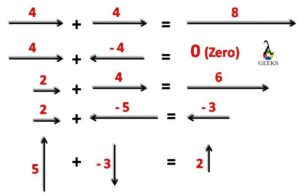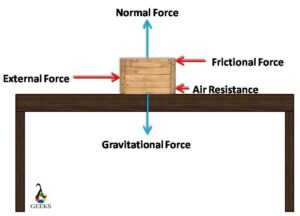The vector sum of all forces that act on a body at the same time is known as the net force.
Since net force is the sum of all the forces acting on a body, and as fore is a vector quantity, it naturally makes net force a vector quantity, having magnitude as well as direction.
Net force can also be referred to as the resultant force.
In this article, we shall try to find is net force a vector? Though we’ve already established it above, we shall try to find out why and how.
What is Net Force?
Before answering the question, why is net force a vector? Let us first understand what the net force is?
The net force is the vector sum of all the forces that act on a body at a given time.
The net force appears when multiple forces act on a body. This net force generally causes acceleration to the body. Now, accelerating does not necessarily mean increasing speed; it generally means the change in speed. So, the decrease in speed is also known as acceleration.
So, if a body starts to move with the help of the net force, a time will come when the body will slow down; it is also known as acceleration, and the word generally used for that is deceleration. So, the body will decelerate with the help of net force itself. The magnitudes of net force will change, which causes the deceleration.
When the net force is zero, it means that the body is in motion, but it is not accelerating (it has constant speed), or the body is at rest.
When the net force has a non- zero value, it means that the body is accelerating. Sometimes, this value may have a negative sign, it expresses the direction of the body.

In vector addition, the size of the arrow represents the magnitude of the vector quantity. The length of the arrow is equal to the magnitude of the quantity.
The vectors are added when the arrow- heads point in the same direction, even if the direction is otherwise than shown in the picture above.
They follow simple mathematical rules. The arrows are just to represent the direction. As evident from the picture above, if one arrow is in the opposite direction from the other arrow, its magnitude will have a negative component.
From the above picture, it is evident that +4 and -4 results in 0 net force. Therefore, when the net force is zero, all the forces are balanced. The rest of the examples are simply the case of unbalanced force. So when the forces are unbalanced, it causes acceleration in the body. This acceleration progresses in the direction of the force with a greater magnitude than the other quantity.
The formula for calculating the net force is given as:
FNET = F1 + F2 + F3 + ………. + FN
| Where, | FNET = Net Force |
| F1, F2, F3, … FN = Forces acting on a body |
If the forces acting on a body have different S. I. Units, then the units are converted into Newton (the S. I. Unit of force), and then the forces are added so that it is easier to add and saves a lot of mess.
If a net force affects an object, that object will accelerate. Conversely, if the object accelerates, it must be influenced by the net force. The magnitude of the net force acting on an object is equal to the object’s mass.
Why is net force a vector?
Anything that has magnitude and direction is known to be a vector.
Theoretically, a quantity must follow certain mathematical rules to prove that it is a vector. These rules are recognized as the laws of vector addition.
Read more about the laws of vector addition on Is Force a Vector Quantity.
Let us take an example for understanding is net force a vector. Say a box is lying on a table. Various forces will work on this box. Initially, when the box is immobile, a gravitational force will pull the box in the downward direction, and an equivalent normal force will oppose this force and pull the box in the opposite direction, i.e., the upward direction. Therefore, these forces stabilize each other and align in an equilibrium position, and we say that the box is NOT moving or it is stationary.
In situations like these, where an object is placed on a table, the normal force is also referred to as the supporting force or the contact force.
No force can ideally balance each other; each and every force is unbalanced. There will always be a minor difference between the magnitudes of the two forces, but this difference is so small that it can be neglected. And hence we can say that the forces balance each other.
Newton’s first law of motion states that ‘a body will remain in its state of motion or rest until an external force is applied to it.’ So, when a body is at rest, it does not mean that no forces are acting on it. It simply means that the forces acting on it have the same magnitude but in the opposite direction, and hence, these forces balance each other, and the net force is zero. Thus, it seems as if no forces are acting on it.
If we want to slide the box in one direction, either left or right, we apply force (push) in that direction. Say we want to move the box on the right side; we push it from the left side to the right side. This means that we applied an external unbalanced force on the box to change its state of rest.

Now the question arises, why is this external force unbalanced?
This external force is unbalanced as there will be a force in the opposite direction, known as the frictional force, but it will not be of the same magnitude as that of the external force, and hence, the external force will be unbalanced. In this case, the magnitude of the external force will be considerably more significant than the frictional force.
On the side of frictional force, there will also be air resistance acting in the opposite direction to that of the external force, but it won’t be essential. Even after combining the magnitudes of the air resistance and frictional force, it won’t be equal to the applied external force. So, the box will not be in an equilibrium position anymore, and thus, with the help of external force, it will move in the right direction.
Thus, as the gravitational force and the normal force balance each other out, the box will not move vertically. But, as the external force and the frictional force do not balance each other, and the magnitude of the external force being greater than the frictional force, the box will move in the horizontal direction. More specifically, in the right direction.
Read more on How to Find Magnitude of Net Force.
The direction is an essential component to be considered for a quantity to be a vector. As force is a vector quantity, and as the net force is the sum of all forces, one can anticipate net force to be a vector quantity.
Also Read:
- Net force vs force
- Is magnetic force a contact force
- Electrostatic force and charge
- Is tension a conservative force
- External forces examples
- Force on moving charge in electric field
- Magnetic field and force
- How to find tangential force
- Kinetic friction vs kinetic force
- Torque vs force
I am Durva Dave, completed my post-graduation in Physics. Physics fascinates me a lot and I like in knowing the ‘Why’ and ‘How’ of everything that unfolds in our universe. I try to write my blogs in simple yet effective language so that it is easier for the reader to understand as well remember. I hope with my curiosity I am able to provide the readers for what their looking for through my blogs. Let’s connect through LinkedIn.